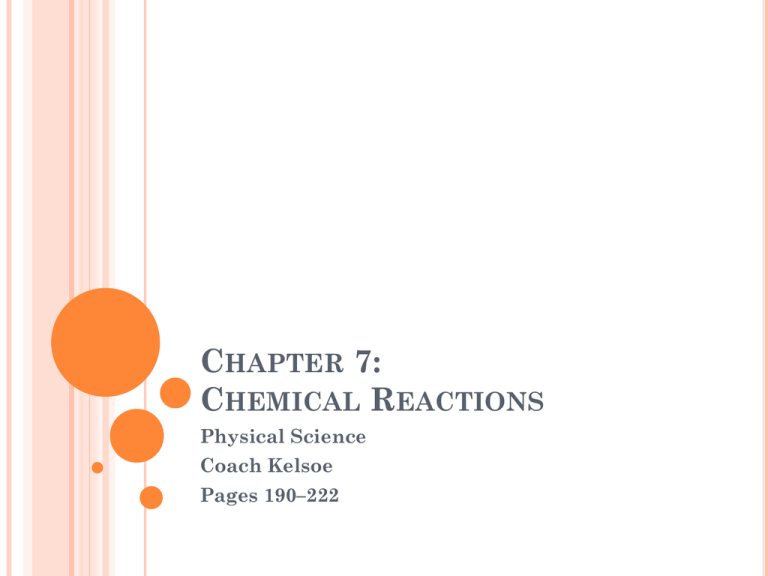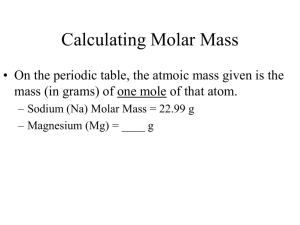Chapter 5: The Periodic Table
advertisement

CHAPTER 7: CHEMICAL REACTIONS Physical Science Coach Kelsoe Pages 190–222 SECTION 7–1: DESCRIBING REACTIONS Physical Science Coach Kelsoe Pages 192–198 OBJECTIVES Interpret chemical equations in terms of reactants, products, and conservation of mass. Balance chemical equations by manipulating coefficients. Convert between moles and mass of a substance using molar mass. Calculate amounts of reactants or products by using molar mass, mole ratios, and balanced chemical equations. CHEMICAL EQUATIONS A useful way of describing a change is to state what is present before and after the change. A useful description of a chemical reaction tells you the substances present before and after the reaction. In a chemical reaction, the substances that undergo change are called reactants. The new substances formed as a result of that change are called products. USING EQUATIONS TO REPRESENT REACTIONS During a chemical reaction, the reactants change into products. You can summarize this process with a word equation: To describe the burning of charcoal, you can substitute the reactants and products of the reaction into the word equation as follows: Reactants Products Carbon + Oxygen Carbon dioxide You can simplify the word equation by writing the reactants and products as chemical formulas: C + O2 CO2 USING EQUATIONS TO REPRESENT REACTIONS A chemical equation is a representation of a chemical reaction in which the reactants and products are expressed as formulas. There are many different ways you can read these equations: C + O2 CO2 CONSERVATION OF MASS During chemical reactions, the mass of the products is always equal to the mass of the reactants. This principle, established by French chemist Antoine Lavoisier, is known as the law of conservation of mass. The law of conservation of mass states that mass is neither created nor destroyed in a chemical reaction. This idea laid the foundation for modern chemistry. CONSERVATION OF MASS For instance, using our charcoal formula, we can see that one molecule of carbon (C) and one molecule of oxygen (O2) forms one molecule of carbon dioxide (CO2). The mass of one carbon molecule and one oxygen molecule is equal to the mass of one carbon dioxide molecule. Just like doubling a recipe, you can double, triple, or do any multiple of a chemical formula! BALANCING EQUATIONS In the charcoal equation, there are the same number of carbon atoms and oxygen atoms on both sides of the equation, but not every equation is balanced at first. Take for instance the combustion of space shuttle fuel hydrazine (N2H4). When it goes through combustion, its formula is unbalanced: N2H4 + O2 N2 + H2O BALANCING EQUATIONS In order to show that mass is conserved during a reaction, a chemical equation must be balanced. You can balance a chemical equation by changing the coefficients, the numbers that appear before the formulas. In our hydrazine formula, since there are no coefficients, we assume them to be one. N2H4 + O2 N2 + H2O 1N2H4 + 1O2 1N2 + 1H2O BALANCING EQUATIONS As you balance equations, you should NEVER change the subscripts of a formula. Changing the subscripts changes the identity of that reactant or product. The first step in balancing an equation is to count the number of atoms of each element on each side of the equation. What needs to be balanced in our hydrazine equation? BALANCING EQUATIONS The next step is to change one or more coefficients until the equation is balanced. N2H4 + O2 N2 + 2H2O Our equation is now balanced. It tells us that one molecule of hydrazine and one molecule of oxygen produces one molecule of nitrogen and two molecules of oxygen. COUNTING WITH MOLES Chemists need a practical unit for counting things involving chemistry. Although you can describe a reaction in terms of atoms and molecules, these units are too small to be practical. It would be like measuring the distance from here to Birmingham in centimeters! Because chemical reactions often involve large numbers of small particles, chemists use a counting unit called the mole to measure amounts of a substance. COUNTING WITH MOLES A mole (mol) is an amount of a substance that contains approximately 6.022 x 1023 particles of that substance. This number is known as Avogadro’s number. In chemistry, a mole of a substance generally contains 6.022 x 1023 atoms, molecules, or ions of that substance. For instance, a mole of iron is 6.022 x 1023 atoms of iron. MOLAR MASS The mass of one mole of a substance is called a molar mass. For an element, its molar mass is the same as its atomic mass, but the unit is “grams” instead of “amu.” For a compound, you can calculate the molar mass by adding up the atomic masses of its component atoms, and then expressing this sum in grams. For example, the molar mass of carbon dioxide (CO2) is 44.01 grams. The one atom of carbon has a mass of 12.01 grams and the two oxygens have a total mass of 32 grams. The sum of the two is 44.01 grams. MOLE-MASS CONVERSIONS Once you know the molar mass of a substance, can you convert moles of that substance into mass, or a mass of that substance into moles. For either calculation, you need to express the molar mass as a conversion factor. For example, the molar mass of CO2 is 44.01 grams, which means that one mole of CO2 has a mass of 44.01 grams. 44.01 g CO2 1 mol CO2 1 mol CO2 OR 44.01 g CO2 MOLE-MASS CONVERSIONS Suppose you have 55.0 grams of CO2. To calculate how many moles of CO2 you have, multiply the mass by the correct conversion factor. 55.0 g CO2 x 1 mol CO2 44.01 g CO2 = 1.25 mol CO2 CHEMICAL CALCULATIONS In chemical reactions, the mass of a reactant or product can be calculated by using a balanced chemical equation and molar masses of the reactants and products. Chemical equations can be read as recipes for making new substances. CONVERTING MASS TO MOLES, MOLES TO MOLES, AND MOLES TO MASS You must use a molar ratio in any conversion problem. See board for examples. VOCABULARY Reactants Products Chemical equation Coefficients Mole Molar mass




